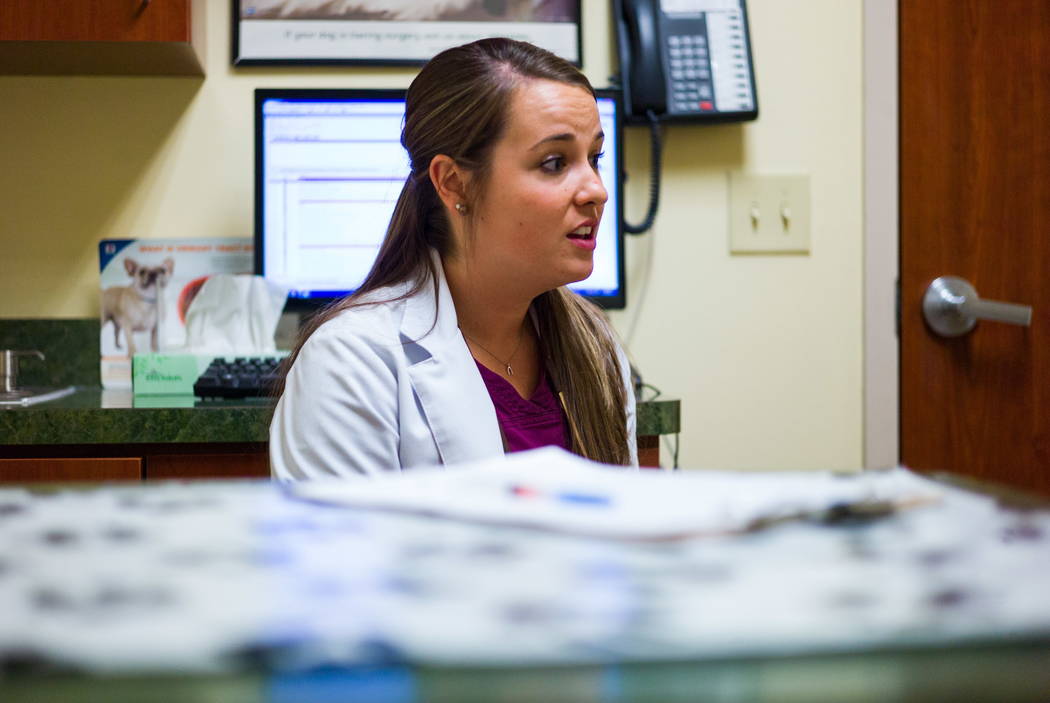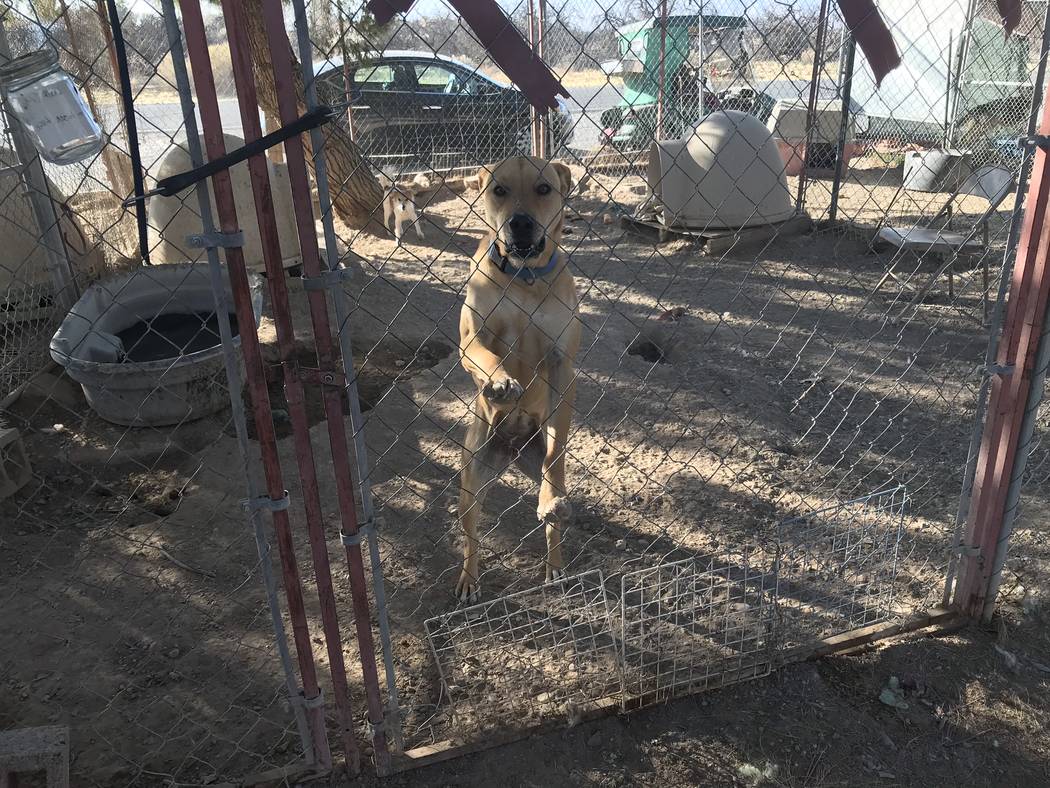Experts on the lookout for canine influenza in Nevada
Veterinarians and animal shelter facility owners across Southern Nevada are taking precautions for the potential spread of a new strain of canine influenza that has spread to the northern portion of the state.
A strain of canine influenza, H3N2, that first hit the U.S. about three years ago, made its way to Northern Nevada this year, with more than 200 positive test counts in the region as of March 7, according to a tracking website by Cornell University’s College of Veterinary Medicine.
It joins an older strain, H3N8, that has been present in the state since 2015, also mainly confined to Northern Nevada.
Kim Simon, a director at West Star Ranch, a no-kill animal rescue in Pahrump, said the group “has adopted a policy of holding new rescues in isolation from our general dog population for three weeks,” which was suggested by an area veterinarian.
Simon, however, said to the best of the group’s knowledge, canine influenza hasn’t made it to southern Nye County.
But West Star volunteers are keeping an eye out for symptoms in the more than two dozen dogs that are typically housed at the organization’s 780 E. Manse Road location. The facility also houses dozens more cats and peacocks.
“Our volunteers are on alert for any animal exhibiting the symptoms of the flu, including coughing and sneezing, nasal discharge, fever and lethargy,” Simon said. “We are also working to raise funds to allow us to vaccinate our animals ahead of a possible flu epidemic.”
West Star recently expanded its thrift store operations that help fund the care and maintaining of the animals at the property.
Flu, its origin
The H3N2 canine flu strain first made its way to the U.S. in 2015 across several parts of the country including California and Idaho. In the next two years following that time, the strain reached other parts of the West, including Arizona and Washington, and most recently, the northern half of Nevada.
The H3N2 strain has yet to hit the southern portion of the state, though it could in the future.
“I was shocked it took so long to get here (to Nevada),” Dr. Travis McDermott, hospital director at Durango Animal Hospital in Las Vegas, said of the new strain in an interview in February with the Las Vegas Review-Journal. “It’s going to be a big deal, I think.”
Dr. Debbie White, a veterinarian at Craig Road and Lone Mountain animal hospitals, also predicted the illness will spread here, during an interview earlier this year with the Review-Journal.
“People in Vegas, we kind of think we don’t have infectious disease and we live in a bubble,” she said. “But that’s not the case.”
Symptoms, what to expect
In the past, veterinarians typically only recommended the vaccine for dogs traveling to an area where the flu was present. But this year, many vets are telling pet owners it’s better to be safe than sorry.
The symptoms of dog flu resemble those of kennel cough, a highly contagious canine respiratory disease, or even the human infection: coughing, sneezing, fever and lethargy. And like the human flu, dog flu can kill.
“Eight to 10 percent will die from it,” McDermott said. “The scary thing about it is that it’s extremely contagious,” though not to humans.
For dogs boarded at Durango Animal Hospital, the vaccine is mandatory, McDermott said. Dogs who come into close contact with other dogs at locations like parks, kennels or shelters are at higher risk for contracting the virus and also are recommended to be vaccinated.
Infected dogs can transmit the flu for about three weeks — even if they never come down with symptoms — as can a pet owner who interacts with an infected dog and then a healthy one. In addition to direct contact, the virus can also spread through contaminated objects and a cough or sneeze.
“The dogs in Las Vegas are naive, (meaning) they’ve never seen this virus,” White said. “And that means just about every dog that encounters the virus is going to become infected.”

As in humans, the vaccine, which protects against both strains, isn’t 100 percent effective, though it can dampen symptoms if a dog contracts the flu.
Harley, an energetic 1½-year-old Doberman Pinscher, stood perfectly still recently as Dr. Brittney Spurling at the Cheyenne West Animal Hospital administered her flu shot. Veterinarians there have been notifying their clients via email about the concern. That’s how Harley’s owner, who asked not to be named, heard about the shot.
Spurling said she was particularly worried when colleagues in Reno told her they’d dealt with the Northern Nevada outbreak firsthand and urged dog owners to visit their veterinarian to get the flu vaccine and a booster shot two to four weeks later.
“We’re just trying to hope for the best and prepare for the worst,” she said.
Suzanne Zervantian, doctor of veterinary medicine at All Creatures Animal Hospital, said there two types of vaccines, one for each strain of canine influenza.
“There is no evidence that either vaccine is cross-protective against the other strain; in other words, the canine influenza H3N8 vaccine has no efficacy against the H3N2 strain and vice-versa,” she said in a written statement. “Even if your dog was previously vaccinated against canine influenza, it may not be protected against the newer strain unless it was the bivalent vaccine.”
Zervantian continued, stating, “dogs will not have full immunity until seven to 10 days after the second immunization in the initial series.”
“When dealing with canine influenza, prevention is better than the disease; however, there is no need for panic,” she said. “As a pet owner it is important to gather the facts, assess the risks and benefits of a vaccine, treatment or procedure, then make an informed decision for the individual pet.”
Jeffrey Meehan is a reporter for the Pahrump Valley Times. Jessie Bekker is a reporter for the Las Vegas Review-Journal.

















